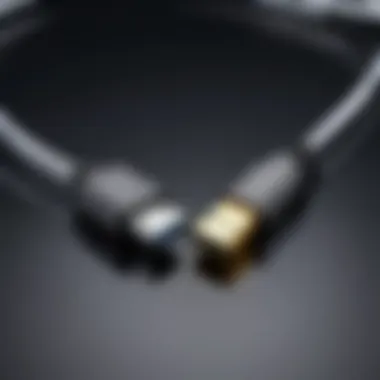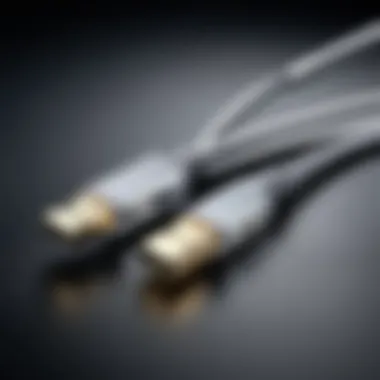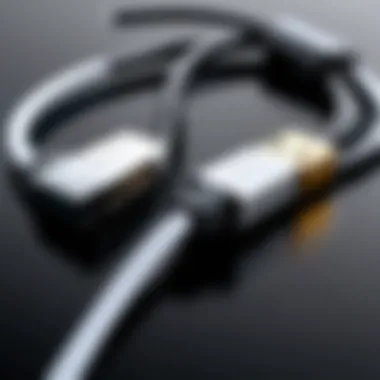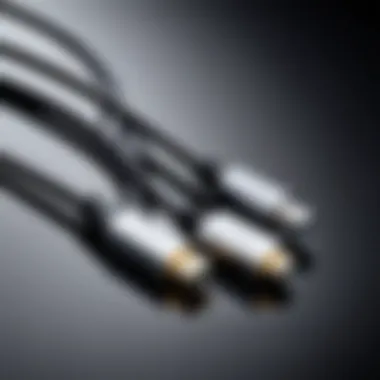Understanding 3Amp USB C Cables for Modern Technology


Intro
The evolution of USB technology has brought several advancements, among which the 3Amp USB C cable stands out for its impressive capabilities. As our devices require faster charging and data transfer, understanding the significance of a 3Amp USB C cable is essential in optimizing our modern tech experience. These cables not only facilitate faster performance but also enhance the overall user experience in various applications. This article aims to illuminate the technical nuances, compatibility, and practical applications of this cable type, catering specifically to tech-savvy individuals and Android users.
Product Overview
Specifications
A 3Amp USB C cable is designed to handle a current of up to 3 Amperes (3A). This allows for a more rapid charging process compared to lower amperage cables. The typical voltage for these cables ranges up to 20 Volts, which means they can deliver a power output of 60 Watts, suitable for charging a variety of devices, from smartphones to laptops. A key aspect to note is that while these cables support fast charging, the actual charging speed may depend on the device and charger compatibility.
Design
The design of a 3Amp USB C cable is particularly noteworthy. This type of cable uses a reversible USB C connector, allowing users to plug it in either way. The build quality often includes durable materials, which enhances longevity and resistance to wear. This design choice contributes to ease of use, making it a preferred option for many users.
Features
Some key features of 3Amp USB C cables include:
- Fast Charging Capability: Supports rapid charging for compatible devices.
- Data Transfer Speeds: Capable of transferring data at rates up to 10 Gbps, depending on the specific model.
- Compatibility: Works with various devices including laptops, smartphones, and tablets across different brands.
Pricing
Prices for 3Amp USB C cables can vary significantly depending on the brand and features offered. Basic models may start at a few dollars, while premium cables with advanced features could go for $20 or more. The balance between quality and price should be assessed when making a purchase.
Performance and User Experience
Speed
The speed of a 3Amp USB C cable is one of its most defining features. For users who frequently transfer large data files or require quick device charging, the performance is a noticeable advantage. Charger and device models that support 3Amp are critical in ensuring that users experience the benefits fully.
Battery Life
Utilizing a 3Amp USB C cable can have a positive impact on battery life. By charging devices faster, users spend less time connected to a power source, which can indirectly help maintain battery health over time. However, it’s essential to match your device with a compatible charger to reap these benefits.
User Interface
User experience with a 3Amp USB C cable is generally streamlined. Its compatibility with various devices simplifies the usage, and the reversible connector design enhances convenience.
Customization Options
Some brands offer customization options, such as different lengths and colors. This can appeal to users looking for specific aesthetics or who need different lengths for various applications.
Comparison with Similar Products
Key Differences
When compared to standard USB cables, the 3Amp USB C cables excel in a few key areas:
- Charging Speed: Traditional USB cables often support lower amperage, resulting in slower charging times.
- Data Transfer Rates: USB C cables typically offer superior data transfer rates, making them suitable for tasks such as file sharing and syncing.
Value for Money
Investing in a 3Amp USB C cable can yield long-term benefits. The enhanced performance justifies the relatively higher price tag, particularly for frequent users of high-performance devices. In contrast, cheaper cables may lead to slower performance and higher chances of wear and tear.
Expert Recommendations
Best Use Cases
For individuals who frequently travel and use multiple devices, a 3Amp USB C cable is advantageous. Whether charging laptops or smartphones, its versatility makes it an ideal choice.
Target Audience
The primary target audience includes tech-savvy individuals, particularly Android users and professionals who rely on fast charging and data transfer capabilities. Those who own multiple devices can benefit from the cable's versatility.


Final Verdict
Preamble to USB Technology
USB Type-C, commonly referred to as USB C, stands as a significant advancement in the evolution of universal serial bus technology. This interface enhances data transmission and charging efficiency across a multitude of devices. Understanding USB C technology is essential as it lays the groundwork for recognizing the capabilities of cables such as the 3Amp USB C cables.
The importance of this technology lies in its versatility and robustness. USB C connectors can transmit power, data, and video simultaneously through a single cable. This multifunctionality not only simplifies connections but also reduces cable clutter. It supports various protocols including USB 3.1, Thunderbolt 3, and DisplayPort, ensuring it meets the needs of modern users.
Several benefits emerge from utilizing USB C technology. For one, the reversible design allows users to connect devices without concern for orientation. This seemingly simple feature enhances user convenience significantly.
Furthermore, the standard's ability to handle up to 100 Watts of power makes it suitable for a wide range of devices, from smartphones to laptops. With devices increasingly demanding higher power, USB C meets the challenge efficiently.
Origin and Evolution of USB Standards
The lineage of USB standards dates back to the mid-1990s, aimed at standardizing connections between computers and peripherals. USB 1.0, released in 1996, marked the beginning, gradually evolving through USB 2.0 and USB 3.0 to the current USB C standard established in 2014.
USB 2.0 brought notable improvements such as higher data transfer rates. USB 3.0 further enhanced this, allowing for speeds of up to 5 Gbps. The development of USB C was inspired by the need for greater versatility, enabling faster charging, improved data transfer, and multimedia output capabilities, all within a compact connector.
Key Features of USB Connectors
USB C connectors boast several key features that distinguish them from their predecessors:
- Reversibility: Users can connect devices without worrying about the orientation.
- Higher Power Delivery: Capable of delivering up to 100W, making it suitable for a wide array of devices.
- Faster Data Transfer: Depending on the version, USB C can support speeds up to 40 Gbps with Thunderbolt 3.
- Support for Multiple Protocols: USB C can accommodate different protocols, including video output through HDMI and DisplayPort.
These distinctive features facilitate a more seamless user experience, highlighting the significance of USB C in today’s technology landscape.
Understanding Amp Ratings
Understanding the amp ratings in USB C cables is crucial for comprehending their functionality and efficiency. In technical terms, amperage reflects the electrical current a cable can safely handle. This directly influences both charging speeds and the performance of connected devices. Given the rapid evolution of technology, especially in gadgets like smartphones and laptops, the demand for higher amperage capabilities has continued to grow. Thus, grasping the significance of these amp ratings becomes vital for any tech-savvy individual.
What Does 3Amp Mean?
The term "3Amp" refers to the maximum amount of current that a cable can transmit at a given time, specifically three amperes. When we consider the context of USB C technology, this means that a 3Amp USB C cable can theoretically allow for a faster charging cycle compared to lower-rated cables. This increased rate can lead to improved efficiency when powering devices. Essentially, it indicates that the cable has been designed to manage more power, which is essential for modern electronics that often require quick recharges.
Higher amperage ratings ensure devices can charge faster, thus optimizing user experience for those always relying on their gadgets.
Importance of Amperage in Charging
The significance of amperage in the context of charging cannot be overstated. Higher amperage allows devices to draw more power concurrently. This capability is particularly important in situations where time efficiency is a concern. For instance, a smartphone that can charge at 3Amps will complete a charging cycle substantially faster than one limited to 1Amp. Additionally, when considering battery health, fast charging can help maintain the lifespan of lithium-ion batteries typically used in modern devices, as they tend to operate best when charged efficiently.
Moreover, incorporating a 3Amp USB C cable not only enhances charging but also impacts data transfer rates. Devices can synchronize data quicker, offering a seamless experience especially when transferring large files or backing up data. Tech-savvy users understand how vital these factors are, especially in professional settings, where time translates directly into productivity.
Applications of 3Amp USB Cables
3Amp USB C cables represent a significant advancement in the world of connectivity. Their ability to handle higher power levels and transfer rates make them essential tools for modern devices. The applications of these cables are broad and varied, affecting how we charge and transfer data between devices. Understanding these applications helps users maximize performance and efficiency in their technology usage.
Fast Charging Capabilities
One of the primary applications of 3Amp USB C cables is their fast charging capabilities. Compared to standard cables, which often provide lower amperage, 3Amp cables are designed to deliver more power. This enables devices to charge more quickly, reducing downtime. Smartphones, tablets, and laptops can all benefit from this increased speed.
- Efficiency: With a higher current output, devices reach full charge faster than ever. This is particularly useful for users with busy schedules who cannot afford long waiting times.
- Device Compatibility: Fast charging is supported by various devices, such as the Samsung Galaxy S series or Apple MacBook Pro, both of which utilize USB C connections for maximizing charge rates.
- Safety Features: Many 3Amp cables include safety protocols that protect devices from overcharging or overheating, making them a reliable option for consumers.
Data Transfer Speeds Associated with 3Amp Cables
Apart from charging, 3Amp USB C cables also contribute to enhanced data transfer speeds. The specifications of these cables allow for rapid data exchange, which is critical for users transferring large files.
- High Bandwidth: Many 3Amp USB C cables support impressive data throughput rates, often reaching up to 10 Gbps, especially when paired with USB 3.1 technology. This allows for seamless video streaming or large file transfers.
- Device Integration: Various devices leverage these speeds. For instance, users exporting high-resolution video from GoPro Hero cameras will notice significantly faster uploads when using a compatible 3Amp cable.
- Versatile Use Cases: Beyond typical file transfers, these cables are valuable for connecting to monitors, external drives, and other peripherals, enhancing the overall user experience for content creators or professionals relying on quick data exchanges.
"In today's fast-paced environment, every second counts. 3Amp USB C cables effectively reduce charging and transfer time, contributing to overall efficiency."
Compatibility Issues
When discussing 3Amp USB C cables, understanding compatibility is essential. These cables are designed to work seamlessly with various devices, including smartphones, laptops, and other gadgets. However, compatibility factors can greatly influence performance.
Knowing which devices use these cables ensures efficient charging and data transfer. A mismatch in specifications can lead to poor performance or even damage to the device. Hence, awareness of both device compatibility and backward compatibility helps users choose cables that suit their needs effectively.


Device Compatibility with 3Amp USB Cables
Smartphones
Smartphones are among the most common devices utilizing 3Amp USB C cables. The high current output allows for rapid charging, meeting the demands of users relying on their phones for communication, entertainment, and work. Modern smartphones often support fast charging, significantly reducing downtime.
A key characteristic of many smartphones is their ability to leverage higher amperage, which translates into quicker recharges for daily activities. However, it is crucial to note that not all smartphones support this feature.
A vital unique feature would be the power delivery (PD) capability. While beneficial for fast charging, some users might experience drawbacks if they use low-quality cables. These cables may not manage the required power optimally, leading to overheating or even device damage.
Laptops
Laptops represent another significant category benefiting from 3Amp USB C cables. Many new models have adopted this standard, allowing for a single cable to charge and connect peripherals. This standardization simplifies connectivity significantly.
A primary characteristic is their capacity to provide sufficient power for laptops. This eliminates the need for multiple charger types and enhances convenience. Laptops often require higher wattage for functioning or charging.
The standout feature of laptops using these cables is their versatility. Users can easily connect external monitors or storage devices. However, it is important to verify that the laptop supports the 3Amp spec to avoid dissatisfaction during usage.
Other Devices
Other devices encompass a range of electronics, such as tablets, gaming consoles, and some smart home appliances. These devices can also benefit from the attributes of 3Amp USB C cables. They can ensure quick charging and efficient data transfer.
A noteworthy characteristic is the expanding adoption of USB C in various tech. More brands are adopting it, making it increasingly relevant. With the potential for omnipresent compatibility, this trend enhances user convenience significantly.
One unique feature in this area is universal adoption. As devices shift toward USB C, users should be aware of differing power demands. While some devices can charge faster, others may not handle the power well, risking potential complications.
Backward Compatibility with Other USB Versions
In addition to current device compatibility, the backward compatibility aspect of USB C technology warrants attention. Many devices equipped with USB C ports retain compatibility with older versions, like USB 2.0 or USB 3.0. This is highly relevant for users transitioning from older technology.
Because of backward compatibility, users do not need to replace all existing cables and accessories. They can use their new 3Amp USB C cables alongside older devices, thus saving money and reducing electronic waste. However, the charging speed and data transfer rates might be limited when using older accessories. Users should consider these factors when planning their technological setups.
Quality Considerations
Understanding the quality of USB C cables is critical for anyone looking to maximize their device's performance and longevity. The increasing reliance on electronic devices means that the cables we use should not only facilitate interactions but also do so efficiently and safely. High-quality cables minimize risk factors such as overheating, poor data transmission, and device damage. This section emphasizes the importance of distinguishing quality in USB C cables and how it affects user experiences.
Identifying Quality USB Cables
Recognizing a quality USB C cable is paramount. Users should pay attention to several key indicators:
- Construction Material: Quality cables often use durable materials such as braided nylon or thick PVC. These materials provide better resistance to wear and tear.
- Gauge and Length: The gauge of the wire inside the cable affects charging speed. Thicker wires support greater current flow, leading to improved charging efficiency. Likewise, shorter cables often experience less resistance.
- Certifications: Look for cables that are certified by organizations like USB-IF. These certifications indicate compliance with industry standards, ensuring safety and performance.
- Brand Reputation: Established brands such as Anker and Belkin typically prioritize quality in their products. Researching user reviews and ratings can also offer insights into the reliability of a cable.
To illustrate, a cable from a lesser-known brand might appear appealing due to a low price but could lack essential safety features. Investing in a higher-quality option can prevent issues down the line.
"High-quality USB C cables are not just an investment in a product but an investment in the integrity of your devices."
Impact of Low-Quality Cables on Devices
Using low-quality USB C cables can lead to various negative outcomes. First, these cables can generate excessive heat during charging. Over time, this heat can damage battery health and even the internal components of devices. Furthermore, poor quality cables often result in inconsistent electrical flow. Such fluctuations can lead to sudden interruptions during data transfers, potentially corrupting files.
Here are several more specific impacts that low-quality cables can have:
- Slow Charging: Many low-end cables do not deliver adequate current, resulting in slower charging times as compared to their quality counterparts.
- Vulnerability to Damage: Inferior construction can lead to fraying, breaking, or short-circuiting, increasing replacements costs.
- Potential Safety Risks: Cheap cables may lack proper shielding, leading to the risk of electrical shock or fire hazards.
Choosing a quality USB C cable is more than a matter of performance; it's about protecting your devices and ensuring they operate efficiently. The long-term benefits far outweigh the initial cost, making quality an essential consideration in your selection process.
Performance Metrics
Performance metrics play a pivotal role in determining the effectiveness and efficiency of 3Amp USB C cables. The primary metrics worth examining include charging time and data transfer efficiency. These factors not only influence user experience but also aid in choosing the right cables for specific applications. Understanding these metrics allows users to make informed decisions, ensuring their devices operate at optimal levels.
Measuring Charging Time with 3Amp Cables
Charging time is a critical consideration that often dictates the convenience of device usage. With 3Amp USB C cables, this metric provides a reliable gauge of how quickly a device can receive power. The charging time may vary depending on the device's battery capacity and the power adapter used.
When utilizing a 3Amp cable, one can expect a significantly reduced charging time compared to lower-rated cables. This is due to the increased amperage that facilitates faster power delivery. Users often notice that smartphones and tablets charge in a much shorter period. For instance, a device that takes several hours to fully charge with a standard cable might only need about half that time with a 3Amp cable.


Understanding the specific charging times for various devices can help optimally manage battery life and device readiness. To illustrate:
- Smartphones: Typically achieve full charge in 1.5 to 2 hours.
- Laptops: Can charge between 2 to 3 hours, depending on battery size.
- Tablets: Often charge in about 2 hours or less.
These improvements provide not just convenience but also efficiency, allowing devices to be used sooner.
Data Transfer Efficiency
Data transfer efficiency is another vital metric to consider. 3Amp USB C cables support rapid data transfer rates, surpassing those of their earlier counterparts. This efficiency is essential, especially for tech-savvy individuals and those who frequently deal with large files, such as video or high-resolution images.
With USB 3.1 technology, 3Amp cables can enable data transfer speeds up to 10 Gbps. This performance greatly benefits users who require moving substantial data quickly. Whether backing up files or transferring content between devices, the time saved can be noteworthy.
Key benefits of utilizing 3Amp USB C cables for data transfer include:
- Reduced Transfer Times: Large files can be transferred in mere seconds.
- Seamless Workflow: Improved efficiency translates to better productivity in professional environments.
- Compatibility with Higher Speeds: As technology advances, 3Amp cables are future-proofed to accommodate upcoming device enhancements.
In summary, performance metrics such as charging time and data transfer efficiency underscore the significance of 3Amp USB C cables. These metrics do not just reflect the capabilities of the cables themselves but also enhance the overall user experience, making them essential components in modern technology.
Choosing the Right Cable
Choosing the right USB C cable is an essential part of ensuring optimal performance for your devices. Not all USB C cables are created equal, particularly when it comes to their specifications. A 3Amp USB C cable can deliver significant advantages in both charging speed and data transfer rates. The decisions made during the selection process can impact device functioning and longevity. Thus, understanding how to evaluate options thoroughly is critical.
Factors to Consider When Purchasing
When deciding on a USB C cable, several factors should be taken into account:
- Amperage Rating: Ensure the cable supports 3Amp ratings. This ensures fast charging compatible with a majority of devices.
- Certification: Look for cables that are certified by relevant organizations like USB Implementers Forum. Certification assures reliable performance and safety.
- Quality of Materials: The build quality of the cable influences durability. Opt for cables made from robust materials that can withstand bends and pulls.
- Length: Consider the required length based on your usage. Longer cables may offer more versatility but can sometimes lead to a decrease in charging speed.
- Brand Reputation: Recognizing reputable brands that prioritize high-quality standards will guide your decision process.
Recommendations for Top Brands
When it comes to selecting a USB C cable, several brands have established a reputation for excellence:
- Anker: Known for reliable and high-quality products, Anker offers a variety of 3Amp USB C cables designed for efficiency.
- Belkin: This brand provides durable cables that are also highly functional, meeting various specs, including 3Amp ratings.
- UGREEN: UGREEN cables are affordable but do not compromise on performance, making them a sound option for many users.
- Aukey: Their cables are designed for fast charging and data transfer, enjoying good reviews for reliability.
Future Trends in USB Technology
The world of USB technology is evolving at a rapid pace. Understanding the trends that shape this industry is essential for consumers and manufacturers alike. Emerging advancements in USB standards, particularly regarding the 3Amp USB C cables, have significant implications for device compatibility and performance. As technology becomes more integrated into daily life, these trends will play a crucial role.
Staying informed on future trends helps in making better purchasing decisions. For instance, knowing about upcoming standards can help consumers anticipate their technology needs. It's also critical for developers and manufacturers to align their products with these advancements.
Predicted Advancements in USB Standards
The USB Implementers Forum has hinted at several anticipated features for future USB C standards. One notable aspect is increased power delivery capabilities. While 3Amp cables are already efficient, future standards might support power delivery exceeding 100 watts. This can enable even more powerful devices like larger laptops to charge quickly.
Moreover, there is a focus on improved data transfer speeds. Current USB 3.2 standards allow speeds of up to 20 Gbps, but future iterations promise to push this even further, possibly reaching 40 Gbps or more. This could revolutionize how we transfer large data files.
Security features are also expected to improve. Enhanced protocols will protect against unauthorized access and data breaches, making USB connections more secure in various interactions.
The Role of 3Amp Cables in Future Devices
As technology advances, 3Amp USB C cables will remain relevant in the ecosystem. These cables are fundamental to the charging and data transfer needs of many modern devices. Given the increasing power demands of devices, users will benefit from the efficiency of 3Amp capabilities.
For everyday tech users, this means faster charging and reduced downtime. Devices like smartphones, tablets, and laptops will leverage the efficiency of these cables. Furthermore, as IoT devices proliferate, the need for dependable charging solutions that can handle higher demands will be paramount.
In summary, the future trends in USB technology will enhance the capabilities of 3Amp USB C cables. Anticipated advancements will lead to more robust, versatile, and secure technology solutions. Understanding these elements equips consumers and industry players alike to navigate an increasingly complex tech landscape.
Closure
The conclusion of this article serves as a crucial touchstone for understanding the relevance and implications of 3Amp USB C cables in contemporary technology. By synthesizing key insights, it provides clarity on how these cables fit into the broader tech landscape. The significance of this topic extends beyond mere specifications, as it influences daily device interactions and overall user experience.
Summary of Key Points
In summary, several key points highlight the importance of 3Amp USB C cables:
- Enhanced Charging Speed: 3Amp cables facilitate faster charging for compatible devices, reducing waiting time significantly.
- Data Transfer Efficiency: These cables not only support high charging capabilities but also enable rapid data transfer, making them ideal for professionals who require efficiency.
- Compatibility Considerations: Understanding device compatibility ensures users maximize the potential of their USB C cables, avoiding performance bottlenecks.
- Future-Proofing Investments: Choosing quality 3Amp USB C cables can extend the utility of devices, accommodating new standards as technology evolves.
Final Thoughts on the Utility of 3Amp USB Cables
The utility of 3Amp USB C cables cannot be overstated. Their role in modern technology not only enhances performance but also streamlines the user experience. By investing in high-quality cables, tech-savvy individuals and Android users can optimize their devices, ensuring seamless connectivity and functionality. In an era where efficiency and speed are paramount, understanding and utilizing these cables is essential.
"The right cable can significantly enhance the functionality of your devices, making understanding specifications an essential part of tech literacy."







